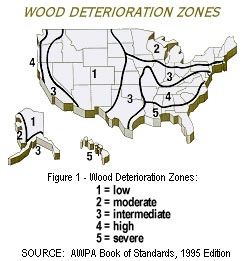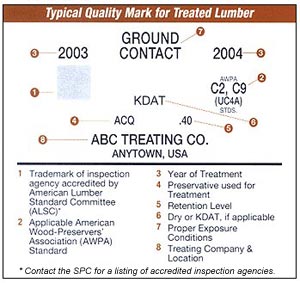

What is Pressure-Treated Lumber? When most wood is exposed to the elements, excessive moisture, or contact with the ground, it will decompose. That is because four conditions are required for decay and insect attack to occur: moisture, a favorable temperature (approximately 50 to 90 degrees Fahrenheit), oxygen, and a source of food (wood fiber). If any of these conditions is removed, infestation and decomposition will not occur. Southern Pine has long been a preferred species when pressure treatment with preservatives is required, because of its ease of treatability. The unique cellular structure of Southern Pine permits deep, uniform penetration of preservative chemicals, rendering the wood useless as a food source for fungi, termites and micro-organisms. Some 85% of all pressure-treated wood is Southern Pine. Why design and build with pressure-treated wood? Figure 1 indicates, by region, the level of wood deterioration throughout the United Stats. As shown, deterioration zones ranging from moderate to severe cover most of the country. To find a source of supply for pressure-treated Southern Pine products, use the Product Locator at www.southernpine.com. Types of Wood Preservatives Several waterborne preservatives are commonly used including Chromated Copper Arsenate (CCA), Alkaline Copper Quat (ACQ), Copper Azole (CA) and Sodium Borate (SBX). As of December 31, 2003 CCA has been withdrawn for most residential consumer-use treated lumber applications. CCA treatment will continue to be allowed for certain industrial, agricultural, foundation, and marine applications. For a list of products that may continue to be treated with CCA, go to www.southernpine.com. Consumer Demand Drives Alternative Wood Preservatives Changing market perceptions and public interest in alternative preservatives has led to changes in the treated wood products offered to consumers at retail. Today, the consumer has more choices when it comes to wood preservatives. In consultation with the Environmental Protection Agency, manufacturers have made a transition to alternative wood preservatives for the residential and outdoor market. Leading preservative manufacturers, Arch Wood Protection, Inc., Chemical Specialties, Inc. and Osmose, Inc. have amended their respective EPA registrations for Chromated Copper Arsenate (CCA), limiting the use of CCA to approved industrial and commercial applications. Regardless of the preservative used, builders and homeowners will find Southern Pine is the species of choice when pressure treated lumber is specified. Southern Pine is preferred because its unique cellular structure permits deep, uniform penetration of preservatives. To learn more about these alternative wood preservatives, go to www.southernpine.com. CCA Information Pressure-treated lumber preserved with CCA (chromated copper arsenate) has a near 70-year track record of safe, effective use. Scientific studies have shown that CCA-treated wood poses no significant measurable risk to humans, animals, plant or marine life when used as intended. The treating industry stands behind the proven safety of CCA-treated products. An important wood preservative in the United States, CCA will continued to be used for EPA-approved industrial and commercial applications. The EPA does not believe there is any reason to remove or replace existing CCA-treated structures, including decks or playground equipment. Furthermore, EPA is not recommending that existing structures or surrounding soil be removed or replaced. To learn more, go to www.southernpine.com. Building Code Requirements Generally, building codes require pressure-treated or naturally durable wood for the following applications:
When used in enclosed locations, the moisture content of the wood should be 19% or less at time of permanent enclosure. Fasteners & Connectors Use of proper fasteners and connectors with treated Southern Pine is very important. Corrosion resistance a must Metal products in contact with pressure-treated wood must be corrosion resistant. Examples include flashing, termite shields, fasteners (e.g. nails, screws, and bolts), and all connecting hardware (e.g. joist hangers, straps, hinges, post anchors, and truss plates). The International Residential Code, Section R319.3 states, "Fasteners for pressure-preservative treated wood shall be of hot-dipped galvanized steel, stainless steel, silicon bronze or copper. Exception: One-half inch (12.7mm) diameter or greater steel bolts." Traditionally, the treated wood industry has recommended hot-dip galvanized or stainless steel fasteners and connectors for wood products treated with Chromated Copper Arsenate (CCA). Hot-dip galvanized or stainless steel fasteners and connectors continue to be recommended for use with alternative wood preservatives (e.g. Alkaline Copper Quat - ACQ - and Copper Azole), but additional clarification is needed to ensure adequate corrosion protection. Type 304 or 316 stainless steel is recommended for maximum corrosion resistance in more severe exterior applications, such as swimming pools and salt-water exposure. Furthermore, stainless steel fasteners are generally required below grade for permanent wood foundations. Hot-dip galvanized fasteners and connectors are generally acceptable for above grade applications. Hot-dip galvanized fasteners should meet ASTM A153. Hot-dip galvanized connectors should meet ASTM A653, Class G185 sheet with 1.85 ounces of zinc coating per square foot minimum. Fasteners and connectors used together should be of the same type (e.g. hot-dip nails with hot-dip joist hangers). Do not use standard carbon-steel or aluminum products in direct contact with pressure-treated wood. Spacer materials or other physical barriers are recommended to prevent direct contact. In addition, electroplated galvanized metal products generally have a thinner layer of protection compared to hot-dip galvanized and are typically not accepted by the building codes for use in exterior applications. Fasteners and connectors coated with proprietary anti-corrosion technologies (other than stainless steel or hot-dip galvanized) are also available for use with treated wood. Consult individual hardware manufacturers for specifics regarding the performance of their products with treated wood. Sealers & Finishes for Pressure-Treated Lumber Finishes Although treated wood is protected against decay and termite attack, the application of a water-repellent sealer to all exposed wood surfaces is recommended upon completion of construction. This sealer will help control surface checking (splitting or cracking) and provide an attractive appearance. Over time, reapplication of a sealer is recommended, perhaps every year or two; follow the manufacturer's instructions. Over several months, pressure-treated Southern Pine lumber will weather naturally to an appealing silver-gray color. Treated Southern Pine lumber will accept a finish similar to untreated material. Most importantly, Southern Pine should be dry before any type of finish is applied. Following construction, most manufacturers of stains and paints recommend a waiting period - from a week to two months - before applying a finish to treated wood, if the project was built with lumber that was not kiln-dried after treatment (KDAT). Most paint manufacturers recommend two coats of a good-quality acrylic latex paint for best results on treated Southern Pine. When applying any type of finish, be certain to follow the recommendations of the paint or stain manufacturer. For more detailed information on finishes for specific applications (fences, decks and porches), go to www.southernpine.com. Proper Handling & Storage of Pressure-Treated Lumber When handled properly, treated wood does not present a health risk. And when it comes to the safe use of treated wood, many of the same safety rules for using untreated wood apply. Refer to the Consumer Information Sheet. Follow these simple tips when using pressure-treated Southern Pine:
The pressure treatment of wood does not prevent the normal passage of moisture
in and out of the lumber, so proper storage (before and during construction)
is important. Treated lumber should be stacked and stored in the same manner
as untreated wood.  Grade & Quality Marks for Pressure-Treated Lumber
Grade & Quality Marks for Pressure-Treated Lumber
To be certain the lumber for your building projects is of a quality to meet its intended use, insist that it be grademarked by an agency accredited by the American Lumber Standard Committee (ALSC). An ALSC-accredited grade mark on Southern Pine dimension lumber (2" or less in thickness) indicates that the lumber has been properly seasoned prior to treatment and that it meets the structural and appearance requirements established for the grade. In addition, all treated Southern Pine should conform to the approved standards of the American Wood-Preservers' Association (AWPA). Each piece should be treated in accordance with AWPA Standards and identified with a quality mark (either ink stamp or plastic end tag) by an ALSC-accredited inspection agency. NOTE: The presence of a plastic end-tag does not necessarily indicate ALSC-accredited treated lumber. The quality mark information should be printed separate from the manufacturer's warranty and guarantee information on the tag. For the lumber grade mark to be valid after treatment, the lumber must adhere to the grade requirements and the moisture content of the grade represented by the grade mark. Design Values & Spans for Pressure-Treated Southern Pine Design values published in the SPIB Grading Rules for Southern Pine Lumber, 2002 Edition, apply to both treated and untreated Southern Pine. Design values for dimension lumber are based on normal use conditions (moisture content of 19% or less). These values are intended for use in covered structures or where the moisture content in use does not exceed 19% for an extended period of time. For applications where the moisture content will exceed 19% for an extended period, tabulated Southern Pine design values must be multiplied by the appropriate wet-service factor, CM. Refer to Table A-2.
Decks are built in all shapes and sizes. The basic structural system is generally the same: decking is supported by joists, joists are supported by beams, which in turn are supported by posts. Posts are then connected or anchored to a foundation or footing, transferring loads from the deck structure to the ground. Recommended maximum span for Southern Pine decking is 24" o.c. (2x4, 2x6, R.E.D.). Typical joist spans are listed in Tables 14, 15 and 16, incorporating the wet-service factor CM for adequate structural design in high-moisture conditions. For additional deck design details (beams, posts, connections) refer to the Forest Products Laboratory Wood Decks Manual available at www.southernpine.com. TREATED SOUTHERN PINE SPAN TABLES
These spans are based on the AF&PA Span Tables for Joists and Rafters and the 2002 SPIB Grading Rules. These three tables are excerpted from SPC's Maximum Spans for Southern Pine Joists & Rafters. They are intended to apply where the moisture content in use will exceed 19% for an extended period of time. Applied loads are given in psf (pounds per square foot). Deflection is limited to span in inches divided by 360 and is based on live load only. Southern Pine Council 2900 Indiana Ave. Kenner, LA 70065 Tel: (504) 443-4464 Fax: (504) 443-6612 E-mail: help@southernpine.com Web site: http://www.southernpine.com | ||||||||||||||||||